
The unveiling of the 2013 Exceptionnelles® winning plant selections is a
much-anticipated event by professionals in the horticultural industry
and amateur gardeners.
The unveiling of the 2013 Exceptionnelles® winning plant selections is a much-anticipated event by professionals in the horticultural industry and amateur gardeners.
Each year brings a stream of new discoveries and 2013 is no exception as it highlights a breathtaking selection of newcomers. Since its inception eight years ago, Les Exceptionnelles has selected more than 70 annual plants to help with decision-making by weekend gardeners and landscapers.
Easy to manage, strong and high performing, these plants were rapidly adopted and have now become an integral part of Quebec’s beautiful signature horticultural landscape.
First organized by the Fondation en horticulture de l’Institut de technologie agroalimentaire (ITA) in Saint-Hyacinthe, which is responsible for the management of the Jardin Daniel A. Séguin, the project gained popularity in Quebec like no other project before.
The reason for its success? There are a number of details that really make a difference. Here are a few of them:
- Public involvement while selecting the winning varieties (nearly 3,000 people each year).
- A strict evaluation of garden performance of the latest novelty plants.
- A neutral and diversified selection committee made up of expert horticulturists from various areas and regions of Quebec, including experts from four of the largest participants from the Gardens of Quebec program.
- Clearly defined selection criteria and regulations.
- Strong program partnership from the industry.
- Work performed in an environment of selflessness, friendship and respect for the consumer.
- Strong brand image (developed by Horticolor).
- Development of visual elements required for retail sales (banners, posters, flyers, pamphlets, labels, table runners, etc.).
- Effective means of communicating with the industry (quick unveiling of winning plants eight months before spring sales begin), in collaboration with professional horticultural industries.
- Free access to texts and quality photographs of winning species.
Broad media coverage based on the collaboration of horticultural journalists and the media (web, television, print media, etc.). Free collaboration is made possible through the project’s neutral philosophy.
Although this list systematically recaps the program’s key elements, its key foundation most certainly remains the human factor, that is, the meeting of passionate individuals who remain true visionaries that are respectful and dedicated to their work, which entails working as a team to achieve a common goal.
AND THE 2013 WINNERS ARE:
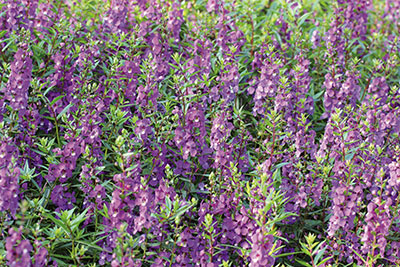 |
|
| PHOTO BY OLIVIER BUTEAU
|
■ Angelonia ‘Summer Snapdragon’ (1)
Blooming season: June to October
Foliage: light green
Exposure: sun, partial shade
Use: container planting, alone or in combination with other plants; flower beds; and massed plantings.
‘Summer Snapdragon’ is an ideal annual for our summers, which are getting hotter and hotter! This angelonia cultivar is easy to grow and is heat and drought-resistant. The free flowering, spire-type blooms are veritable miniature snap-dragons. They are maintenance-free and can withstand rain. Blooming will last through to the first frosts.
The Serenita™ cultivar produces tall, graceful spires that are more compact than those of Serena™, a specimen that was lauded in the 2006 program and therefore is easier to use in combination with other plants.
Of all the colours grown at Jardin Daniel A. Séguin in the summer of 2012, the public preferred the clear purple colour of the ‘Serenita™ Purple’ cultivar, which is easily combined with other plants.
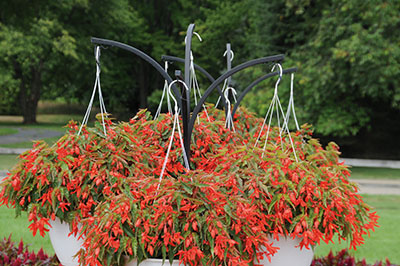
|
|
| PHOTO BY Rock Giguère
|
Bolivian begonia ‘Santa Cruz™ Sunset’ (2)
Blooming season: June to October
Foliage: dark green
Exposure: sun, partial shade
Use: container planting, alone or in combination with other plants; flower beds; hanging baskets.
A spectacular Bolivian begonia, it was the recipient of the 2012 American Garden Award. This new cultivar is the first begonia boliviensis grown from seedlings and is marketed by Benary.
With an abundance of fiery red-orange, bell-shaped flowers ranging from five to 7.5 cm that are larger than cultivars raised from cuttings, this fast-growing begonia offers a spectacular cascade of eye-catching beauty.
‘Santa Cruz™ Sunset’ is a tuberous-type begonia and rapidly assumes a drooping bearing, which is especially enhanced when used in hanging baskets. This horticultural novelty will soon be adopted by all lovers of bright colours!
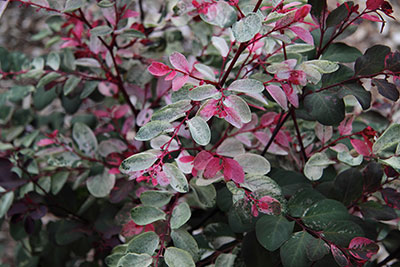 |
|
| PHOTO BY OLIVIER BUTEAU
|
Breynie ‘Roseo-picta’ (Hawaiian Snow Bush) (3)
Blooming season: insignificant
Foliage: pink-cream mottling and reddened stems
Exposure: sun, partial shade
Use: container planting, alone or in combination with other plants; flower beds; borders; massed plantings; specimen planting.
Delicate-looking, it has finely textured leaves of green, pink and cream hues. This mini tropical shrub is extremely versatile and draws attention to the eye every time because of its delicate freshness.
This shrub is quite suitable for pruning as the pruning process multiplies the number of colourful stems. Its upright habit makes it ideal for specimen plantings, as a combination plant or as a border plant for large ornamental plantings. In a sunny area, the pink hue of the foliage will prevail.
The ends of its stems are so colourful they look as if they were dipped in a colouring solution. The plant prefers moderately rich, cool soil.
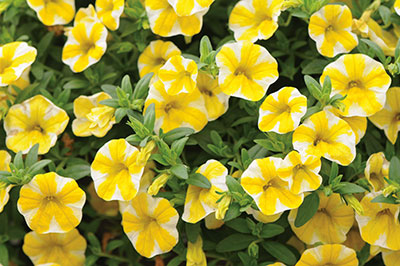 |
|
| PHOTO BY Rock Giguère
|
Calibrachoa ‘Superbells® Lemon Slice’ (4)
Blooming season: June to September
Foliage: soft green
Exposure: sun, light shade
Use: container planting, alone or in combination with other plants; flower beds; hanging baskets.
Among the hundreds of calibrachoas available in today’s market, this one sets itself apart with its exceptional and delightful yellow and white pinwheel colour pattern. This is a first among the calibrachoas!
The design of its blooms is so perfect, it looks like candy. This is a free flowering cultivar, very hardy and dense. The cascading and neat mounding habit of this plant makes it ideal for use in combinations with other plants or in massed plantings.
True to its genus as a Superbells® species, this new plant, however, is resistant to root diseases and less subject to stem breakage and iron deficiency problems found in other plants of the same family. This is a novel plant sure to meet with immediate success!
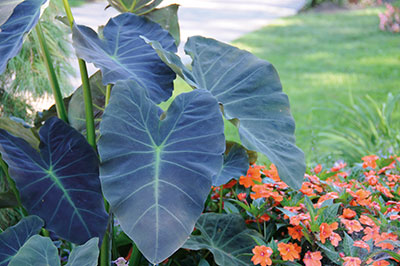 |
|
| PHOTO BY Claude Vallée
|
Colocasia ‘Coal Miner’ (Taro Plant) (5)
Foliage: dark olive leaves with black leaf pattern and distinct white striping
Exposure: sun, partial shade
Use: container planting, alone or in combination with other plants; flower beds; specimen planting; suitable for water gardens or the water’s edge.
A touch of tropical luxuriance! This giant plant, with smoke-coloured leaves shaped like elephant ears, was discovered in a lot of colocasias (taro plants) from India.
The plant requires cool, moist soil conditions and it does best on the water’s edge or by a pond. The soft, green – almost white – striping and contrasting dark-olive green, heart-shaped leaves make it a most decorative choice plant.
In a container, this taro plant will behave like other annuals. In a sunny spot, the plant will reach its maximum colour pattern. Placed near a window and resting in a saucer filled with water, this exceptional plant will easily overwinter inside but will require severe pruning before bringing it in.
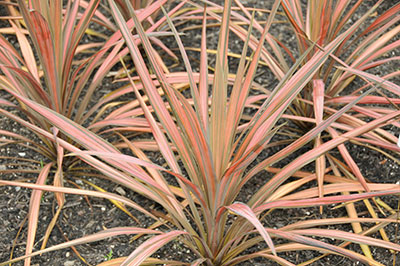 |
|
| PHOTO BY Claude Vallée
|
Cordyline ‘Coral’ (Cabbage Tree) (6)
Foliage: coral, purple with brown-green stripes
Exposure: sun, partial shade
Use: container planting, alone or in combination with other plants; flower beds; massed planting; specimen plant.
Impervious to extreme ambient conditions, this cordyline is ideal for exterior decorating. More sun and drought-resistant than other cordylines, this plant can withstand a weekend by itself when you are away.
‘Coral’ offers coral swords with brown/green stripes with some purple. The colour intensifies with time and sun exposure. This species stems from a breeding program by New Zealander Arthur Rendle and has a strong root system and very dense crown.
The plant may be overwintered inside at temperatures between five and 15 C, or more, if sufficient light is provided, and be brought back outside the following year … more beautiful than ever.
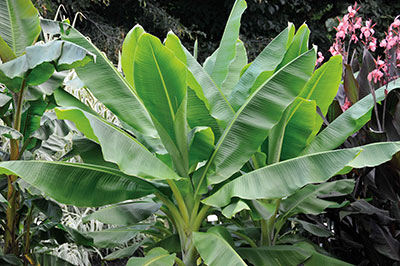 |
|
| PHOTO BY Claude Vallée
|
Ensete glaucum (Snow Banana) (7)
Foliage: soft green
Exposure: sun
Use: large container planting, alone or in combination with other plants; flower beds; massed planting; specimen plant.
The giant ‘Maurelii’ banana plant, which until then was reserved for horticultural fanatics, was a star of Les Exceptionnelles in 2010 and an immediate success.
Again this year, the jury has selected a panama plant, the ensete glaucum, commonly called the “snow banana.” It originates from China where it grows in areas more than 2,700 metres in altitude that are often covered in snow. Despite initial hopes of hardiness, this species is only hardy in zones 9 to 11.
Bigger than the Maurelii, this tropical plant has a thick, waxy and blue, solitary trunk with fine white colouring that makes it appear bluish and sports long and large soft-green leaves.
The banana plant grows rapidly once the heat sets in. It requires a warm location, rich, moist, well-drained soil and a continuous supply of water to reach its full potential. The plant can overwinter inside in a cool and bright location. The leaves should be cut and watering times minimized.
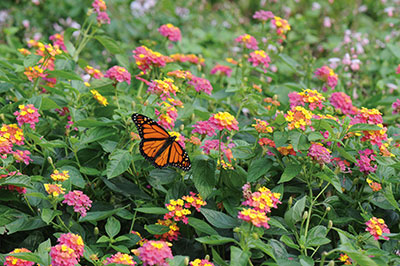 |
|
| PHOTO BY Claude Vallée
|
Lantana ‘Luscious® Berry Blend’™ (8)
Blooming season: June to October
Foliage: dark green
Exposure: sun, partial shade
Use: container planting, alone or in combination with other plants; flower beds; massed plantings; hanging baskets.
This heat-tolerant, drought-resistant lantana cultivar is of generous proportions, easy to grow and can adapt to a multitude of soils. It spreads in a dense and regular shrub-like mound that is a particular favourite of butterflies and will even attract hummingbirds if you have the right biodiversity in your garden.
The bicolour blooms offer pink and yellow hues mixed in with hints of raspberry and lemon. The free-flowering and self-cleaning habit of this plant provides pleasure all season long. Since this cultivar produces no fruits, all of its energy is spent in a constant renewal of its blooms. The plant will survive despite unintentional neglect!
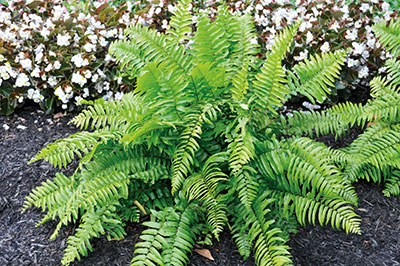 |
|
| PHOTO BY Claude Vallée
|
‘Macho’ Fern (9)
Foliage: dark to soft green depending on exposure
Exposure: sun, partial shade, shade
Use: container planting, alone or in combination with other plants; flower beds; massed plantings; specimen plant.
Do not let this plant fool you with its delicate appearance, as this tropical fern is one of the sturdiest plants in the garden.
Well established as a green houseplant, this fern was introduced by Planterra as an exterior annual. Selected as one of the favourites by the public, it has done so well that judges awarded it with the title of “Exceptionnelle.”
As horticulturist Rock Giguère puts it: “This is a precious addition of texture and foliage in landscapes, as much in the ground as in containers.”
This fern grows equally well in partial shade and in full sun where the foliage becomes lighter.
The plant’s rapid growth and amazing ability to adapt make it a favourite in contemporary designs, where it allows the integration of outdoor living spaces, such as living areas or summer kitchens connected to the main house. ■
SOME VISIONARY PARTNERS
■ Without partners, the program would not be the success it is today. It simply would not exist. Our thanks to Fafard, Unijardin, Passion Gardens, Botanix, Ball Horticulture, JVK, Norseco, the FIHOQ, Horticolor Canada, IQDHO, Plant-Prod Quebec, Teris, Déco Style, l’Association des responsables d’espace vert du Quebec, Compostage GL, Savaria, ITA, Les Fleurons du Quebec, Jardin Daniel A. Séguin, the Montreal Botanical Garden, Jardin Van den Hende, and Jardins de Métis.
 |
|
Claude Vallée, M.Sc., is professor and coordinator of technological innovation in horticulture at the St-Hyacinthe campus of the Institut de technologies agroalimentaire.
Print this page